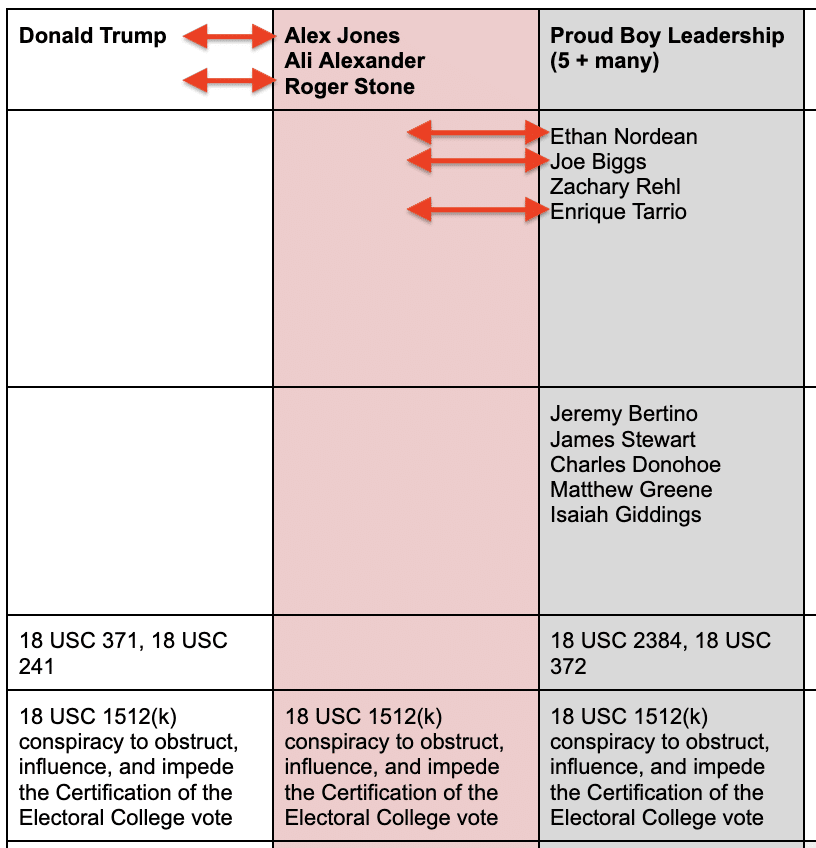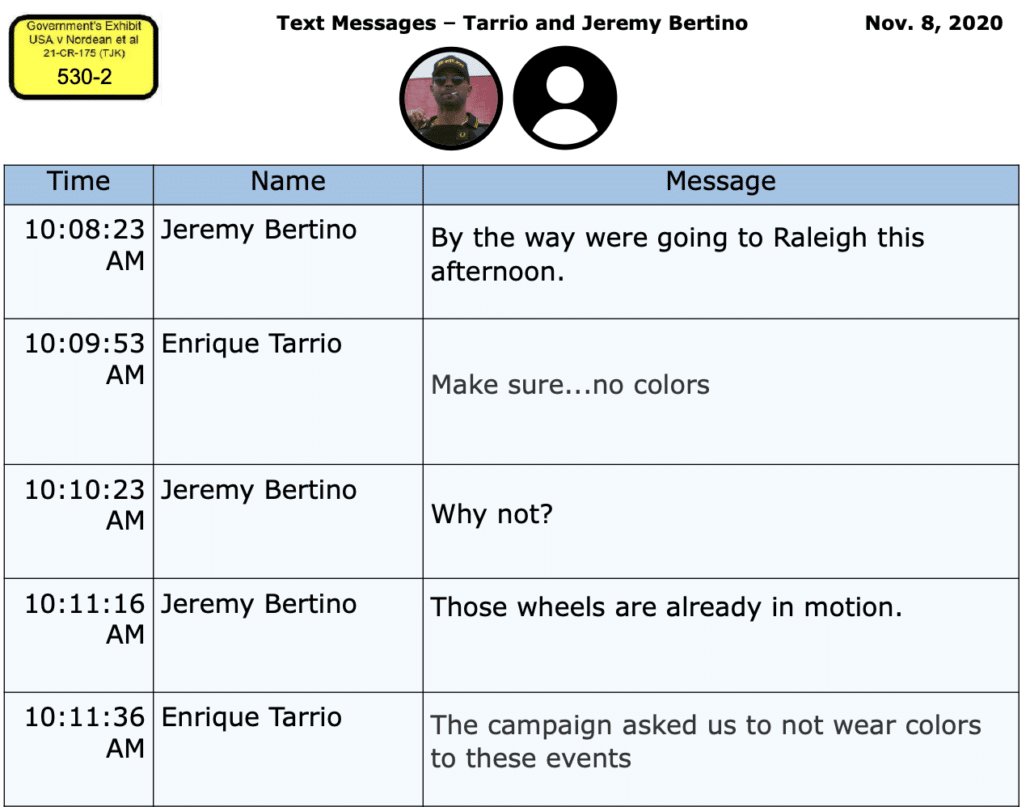Ratifying Sedition: The Proud Boys 404(b) Evidence
As I noted yesterday, the government provided its 404(b) notice in Trump’s January 6 case. 404(b) notices alert the defendant to evidence that may or may not be intrinsic to the case but in any case shows the defendant’s criminal propensity.
In addition to showing how the Trump campaign tried to start a riot at the TCF Center in Detroit, DOJ also wants to show that Trump’s celebration of the Proud Boys bookends his own assault on democracy.
As the filing describes, Trump called out the militia at the first debate, and then — almost three years later — complained that convicted seditionist Enrique Tarrio faces a long sentence.
The Government plans to introduce evidence from the period in advance of the charged conspiracies that demonstrates the defendant’s encouragement of violence. For instance, in response to a question during the September 29, 2020, presidential debate asking him to denounce the extremist group the Proud Boys, the defendant instead spoke publicly to them and told them to “stand back and stand by.” Members of the group embraced the defendant’s words as an endorsement and printed merchandise with them as a rallying cry. As discussed below, after the Proud Boys and other extremist groups participated in obstructing the congressional certification on January 6, the defendant made clear that they were acting consistent with his intent and direction in doing so.
[snip]
Of particular note are the specific January 6 offenders whom the defendant has supported— namely, individuals convicted of some of the most serious crimes charged in relation to January 6, such as seditious conspiracy and violent assaults on police officers. During a September 17, 2023, appearance on Meet the Press, for instance, the defendant said regarding Proud Boys leader Enrique Tarrio—who was convicted of seditious conspiracy—“I want to tell you, he and other people have been treated horribly.” The defendant then criticized the kinds of lengthy sentences received only by defendants who, like Tarrio, committed the most serious crimes on January 6.
DOJ’s plan to show this is not surprising. After all, DOJ kicked off the Proud Boy sedition trial with Trump’s shout out to the Proud Boys.
But the significance, given the way DOJ has structured its conspiracy prosecutions from the start, is far more than damning evidence.
That’s because one of the conspiracy charges against Trump, 18 USC 1512(k), is one of the charges of which the Proud Boy leaders were convicted.
Aside from that public shout-out, which DOJ describes as, Trump speaking “publicly to them,” Donald Trump is not known to have communicated directly with any of them. But as I illustrated in January, Ethan Nordean, Joe Biggs, and Enrique Tarrio all communicated with Alex Jones and Roger Stone (and Owen Shroyer — who has two more days left in his sentence in Oakdale Correctional), even during the attack. Both of them, Jones and Stone — who have not been charged — communicated directly with Trump (and Mark Meadows). Stone’s actions leading up to January 6 were central to the guilty obstruction verdicts in Proud Boy Dan “Milkshake” Scott’s plea and Chris Worrell’s bench trial.
There may be more than that.
At the Proud Boy Leaders trial, for example, prosecutors introduced a series of Telegram chats from the day of, and immediately following, Trump’s shout-out. The men were giddy at Trump’s recognition.
In the wake of Trump’s debate recognition, there was talk of Trump inviting Proud Boys to the White House (Tarrio eventually did visit the White House, in December, as part of a Latinos for Trump event).
There was talk of mobbing election offices.
And, on November 8, Tarrio warned now-cooperating witness Jeremy Bertino not to wear colors because the campaign “asked us” not to do so.
As the campaign was ginning up mobs in swing states, Tarrio at least claimed to have some contact directly with the campaign. Stone is not the only candidate to be Tarrio’s tie to the campaign; Kellye SoRelle, who knew Tarrio from Latinos for Trump, was involved in the mob scene in Michigan.
A month ago, lead Proud Boys prosecutor Erik Kenerson dropped off one of the key pending Proud Boy prosecutions. There are many things that could explain that, but when other prosecutors — like Mary Dohrmann — moved under Jack Smith, that’s the kind of public activity that marked the move.
Several things have made clear in recent days that DOJ doesn’t consider the list of six uncharged co-conspirators in Trump’s January 6 indictment to be exclusive.
In their description of the TCF riot, for example, DOJ described the campaign employee who encouraged rioting (possibly Mike Roman) as “an agent (and unindicted co-conspirator).” Whoever it is would be a seventh co-conspirator.
More curiously, when Tanya Chutkan corrected Trump’s false representation of the indictment in her ruling that he did not have absolute immunity, she described that, “Defendant, along with at least six co-conspirators, id. ¶8, undertook efforts ‘to impair, obstruct, and defeat [that process] through dishonesty, fraud, and deceit,’ id. ¶ 10.” That comment stuck with me, as everyone else who has commented on the indictment has treated the six co-conspirators as an exclusive list. But sure enough, that paragraph she cites describes that the six co-conspirators laid out in the indictment — Rudy Giuliani, John Eastman, Sidney Powell, Jeffrey Clark, Kenneth Chesebro, and probably Boris Epshteyn — were only “among” those with whom Trump conspired.
The Defendant enlisted co-conspirators to assist him in his criminal efforts to overturn the legitimate results of the 2020 presidential election and retain power. Among these were:
If DOJ were ever to charge someone and make it a related case, it would come before Chutkan. That’s just one way that Chutkan might know of specific additional alleged co-conspirators that we wouldn’t yet know.
Conspiracy law doesn’t require co-conspirators to get together in a room to plot together. They need only agree on the objective and take steps to achieve it. If they have networked communications between them, all the better.
At the Proud Boys trial, prosecutors made Trump’s role in their conspiracy clear. Now, leading up to the former President’s own trial, DOJ has said they will present communications that amount to an agreement in September 2020 and ratification of the Proud Boy attack on the country in September 2023.
This is not just damning evidence of fondness for the right wing militia. It’s evidence that Trump pursued the same effort to obstruct the vote certification as the Proud Boys.





